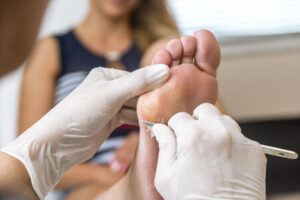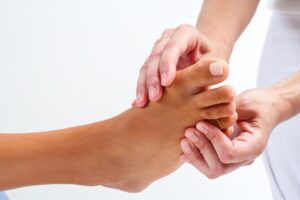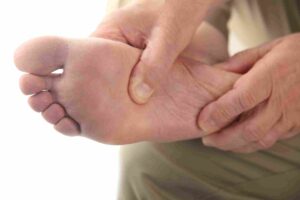Dealing with diabetic calluses can be more than just a matter of foot care; it’s a crucial aspect of managing diabetes and preventing complications. Calluses, those areas of thickened, hardened skin, are common among individuals with diabetes due to the high-pressure points on the feet. They can lead to significant issues if not addressed properly, including ulcers and infections, given the compromised wound healing in diabetes. This guide aims to discuss diabetic callus treatments, providing you with actionable advice and preventative measures to maintain foot health, enhance comfort, and prevent potential complications.
Contents
Are Calluses Bad For Diabetics?
 Yes, calluses can pose significant risks for individuals with diabetes, making their management a critical aspect of diabetic foot care. Here are several reasons why calluses are particularly concerning for diabetics:
Yes, calluses can pose significant risks for individuals with diabetes, making their management a critical aspect of diabetic foot care. Here are several reasons why calluses are particularly concerning for diabetics:
- Increased Risk of Ulceration: For people with diabetes, calluses can lead to foot ulcers. Due to the thickened skin and reduced sensitivity, pressure points under calluses may not be relieved, causing the skin to break down underneath the callus. This can lead to open wounds, known as ulcers. These are difficult to heal in diabetic individuals due to impaired blood circulation and nerve damage.
- Infection: Ulcers and open wounds from untreated or improperly managed calluses can become infected. In diabetics, the body’s ability to fight infection is compromised. It can lead to more severe infections, potentially resulting in cellulitis or even gangrene.
- Peripheral Neuropathy: Diabetics often suffer from peripheral neuropathy, a condition that reduces sensation in the feet. This reduced sensitivity means that pain from a developing callus or ulcer may not be felt. And, leading to delayed treatment and increased risk of complications.
- Decreased Blood Flow: Diabetes can also affect blood flow to the extremities, slowing the healing process for any breaks in the skin caused by calluses. This makes even minor injuries potentially serious and more prone to infection.
- Changes in Foot Shape: Diabetes can cause changes in the shape of the foot and toes, leading to abnormal pressure points that may result in callus formation. These calluses, if not managed properly, can contribute to the development of diabetic foot ulcers.
Given these risks, individuals with diabetes must adopt a proactive approach to foot care. Regular visits to a podiatrist or foot care specialist are recommended for individuals with diabetes. This will help to ensure any issues are identified and treated promptly.
What Are The Best Diabetic Callus Treatments?
Diabetic callus treatments focus on safely reducing the thickness of the callus, preventing infection, and addressing the underlying factors that contribute to callus formation. Here are some common medical treatments for diabetic calluses:
Professional Callus Trimming
 It is a safe and effective method to manage calluses for individuals with diabetes. A healthcare provider, such as a podiatrist, uses sterile instruments to carefully remove the thickened skin. This procedure reduces the risk of developing foot ulcers by decreasing the pressure exerted on the skin underneath the callus. Unlike over-the-counter callus removers, which can contain harsh chemicals or require manual scraping that can damage diabetic skin, professional trimming ensures the skin is not breached, preventing infection.
It is a safe and effective method to manage calluses for individuals with diabetes. A healthcare provider, such as a podiatrist, uses sterile instruments to carefully remove the thickened skin. This procedure reduces the risk of developing foot ulcers by decreasing the pressure exerted on the skin underneath the callus. Unlike over-the-counter callus removers, which can contain harsh chemicals or require manual scraping that can damage diabetic skin, professional trimming ensures the skin is not breached, preventing infection.
Custom Orthotics
Custom orthotics are specially designed shoe inserts that help distribute pressure evenly across the foot, significantly reducing the formation of calluses. These devices are tailored to the specific shape of the patient’s foot, addressing abnormal foot mechanics and providing support where needed. By correcting the alignment and improving the function of the foot, custom orthotics can also alleviate pain and discomfort associated with diabetic foot complications.
Shoe Recommendations
Footwear plays a crucial role in diabetic foot care. Shoes designed for diabetics are wider, deeper, and have soft uppers with no interior seams that could rub against the foot, causing calluses or ulcers. Healthcare professionals can recommend specific brands or features, such as adjustable closures for accommodating changes in foot size due to swelling. The right shoes can significantly reduce the risk of foot injuries. Hence, making daily activities safer and more comfortable for individuals with diabetes.
Medications
Topical medications may be used to soften calluses, making them easier to remove safely. However, these products must be used with caution and under the guidance of a healthcare professional. Some over-the-counter callus removers contain chemicals that can burn or damage the skin. Eventually, this leads to serious complications in diabetics with reduced skin sensitivity. A healthcare provider can prescribe or recommend suitable products that are effective yet gentle on diabetic skin.
Wound Care
For diabetics, the development of an ulcer under a callus is a serious concern that requires immediate medical attention. Wound care involves cleaning the area, removing dead skin and tissue (debridement), and applying appropriate dressings. This process helps promote healing while preventing infection. In cases where an infection is present or at high risk, antibiotics may be prescribed. Regular monitoring by healthcare professionals is essential to ensure the wound heals properly.
Glycemic Control
Effective management of blood glucose levels is foundational in the treatment and prevention of diabetic calluses. High blood sugar can impair circulation and slow down the healing process, increasing the risk of infection and complications from foot injuries. Healthcare providers work with patients to develop a comprehensive diabetes management plan that includes diet, exercise, and medication to maintain optimal glycemic control.
Patient Education
Educating patients on the importance of foot care and diabetes management is critical in preventing calluses and other complications. This includes teaching patients how to inspect their feet daily for signs of calluses, cuts, or infections, and to understand the significance of wearing appropriate footwear. Education also covers the importance of maintaining good glycemic control and adhering to a healthy lifestyle to support overall foot health.
Surgery
In rare cases, if there are significant structural abnormalities in the foot that contribute to callus formation, surgical intervention may be necessary. Surgery can correct the alignment of bones in the foot, relieving pressure points and reducing the risk of callus formation. This option is considered when conservative treatments have failed to provide relief or prevent complications. Surgical interventions require careful consideration. And should be performed by specialists experienced in diabetic foot care.
By addressing calluses through a combination of professional care, individuals with diabetes can significantly reduce their risk of foot-related complications. Ultimately, enhancing their quality of life.
What is the Fastest Way to Heal Diabetic Calluses?
 Diabetic callus treatments at home require careful consideration to avoid complications. While professional medical treatment is the safest approach, several home remedies can support callus care, aiming to keep the skin healthy and prevent calluses from worsening. Here are some home remedies used for diabetic callus treatments:
Diabetic callus treatments at home require careful consideration to avoid complications. While professional medical treatment is the safest approach, several home remedies can support callus care, aiming to keep the skin healthy and prevent calluses from worsening. Here are some home remedies used for diabetic callus treatments:
Daily Foot Inspections
Regular foot inspections are a critical component of diabetic foot care. By examining your feet daily, you can catch early signs of calluses, cracks, sores, or any changes in skin color. This routine helps in identifying potential problems before they escalate into serious complications. Use a mirror to check the bottoms of your feet or ask for assistance if you’re unable to do it yourself.
Gentle Foot Care
Wash your feet daily with lukewarm water and mild soap to remove dirt and dead skin. This can contribute to callus buildup. It’s important to avoid hot water and harsh soaps that can dry out your skin, leading to cracks and potential entry points for infection. After washing, gently pat your feet dry, especially between the toes, where moisture can create a breeding ground for bacteria and fungi.
Moisturize
Applying a diabetic-friendly moisturizer to your feet can help keep the skin supple and prevent calluses by reducing friction. Avoid moisturizing between the toes, as this can lead to excessive moisture, promoting fungal infections. Choose creams or lotions specifically formulated for diabetic foot care, free from fragrances and additives that might irritate the skin.
Use a Pumice Stone
A pumice stone can be used gently on moistened skin to help reduce callus thickness. It’s crucial to use light, circular motions to avoid damaging the skin. Soak your feet in lukewarm water for a few minutes to soften the skin before using the pumice stone. Individuals with diabetes must exercise caution, as reduced sensitivity from neuropathy may lead to excessive rubbing without realizing it, potentially causing skin breakdown or injury.
Keep Feet Dry
Keeping your feet dry is essential to prevent fungal infections and skin breakdown. This can complicate callus conditions. Use absorbent socks made of materials that wick away moisture from the skin, and change them frequently, especially if you’re active or in hot environments. Consider using footpowder in your shoes to help absorb moisture.
Stay Hydrated
Hydration plays a vital role in maintaining skin health. Well-hydrated skin is less prone to cracking and callus formation. Make sure to drink plenty of water throughout the day to help keep your skin elastic and healthy, supporting its barrier function against physical stress and infection.
Avoid Walking Barefoot
Walking barefoot exposes your feet to risks of cuts, scrapes, and the formation of calluses due to direct pressure on hard surfaces. Always wear protective footwear that provides cushioning and support. Even indoors, to protect your feet from injury and prevent the development of calluses.
Limit Exposure to Harsh Chemicals
 Over-the-counter callus removers often contain chemicals, such as salicylic acid. This can be too harsh for diabetic skin, leading to burns or ulcers. Always consult with a healthcare professional before using any chemical products on your feet. They can recommend safe, diabetic-friendly options for managing calluses without risking skin damage.
Over-the-counter callus removers often contain chemicals, such as salicylic acid. This can be too harsh for diabetic skin, leading to burns or ulcers. Always consult with a healthcare professional before using any chemical products on your feet. They can recommend safe, diabetic-friendly options for managing calluses without risking skin damage.
Incorporating these practices into your daily routine can help manage and prevent diabetic calluses effectively. However, these home remedies should complement, not replace, regular medical care from a healthcare provider experienced in diabetic foot management.
Conclusion
Diabetic callus treatments require a combination of professional medical care and diligent home management to prevent complications and ensure foot health. By incorporating daily foot inspections, gentle foot care, proper moisturization, controlling blood sugar levels, and limiting exposure to harsh chemicals, individuals with diabetes can effectively reduce the risk of callus-related complications.
Remember, these strategies are meant to support, not substitute, regular check-ups with healthcare professionals. Taking these steps seriously can make a significant difference in maintaining healthy feet. Hence, overall well-being for those living with diabetes. Do you want to get rid of diabetes? Join our online diabetes treatment program and reverse Diabetes naturally through lifestyle changes such as a Personalized Diet plan, Exercise, Yoga, dieticians, and health coaches.

